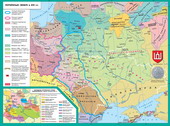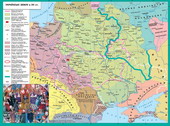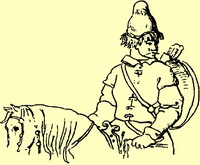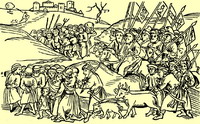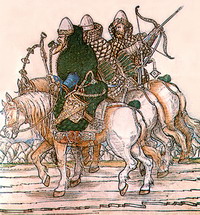Ukrainian lands of Hungary, Moldova, and Moscow State. Crimea and the Ukrainian Black Sea
Plan presentation
- Crimea and Black Sea.
- Transcarpathia within Hungary.
- Bukovina as a part of the Moldavian principality.
- Moscow-Lithuanian War late 15 - early 16 th century.
Timeline
|
1449 |
Create Crimean Khanate |
|
1475r. |
invasion of Turkish troops to the Crimea. Hobby Kafi, Sudak and other Genoese fortress on the southern coast of the peninsula |
|
1478 |
Go Crimean Khanate in vassalage of the Ottoman Empire |
|
1482 |
Kyiv horde devastated the Crimean Khan Mengli Giray |
basic concepts and terms
Bukovina - historical region that encompasses the upper valley of the Prut and Siret. Now this area is part of Ukraine (Northern Bukovina) and Romania (South Bukovina). Name of land occurred in the 14 century. and is derived from the value of "beech forest».
Transcarpathia - the historical region that occupies the southern slopes and foothills of the Carpathian lowlands adjacent to them in the Tisza River basin. Name of the Ukrainian land speaks for itself, because it only from Ukrainian territory, is located behind the Carpathian Mountains.
Yasyr - prisoners that are captured by Tatars and Turks during predatory marches on Ukrainian land.
Janissary - regular Turkish infantry, established at 2 pm. Article 14. Sultan Murad IV the core Turkish army. Originally komplektuvalas of POWs, and later - by forcible recruitment of boys from the Christian population of the Ottoman Empire. Boys navertaly forcibly to Islam, nurtured in the spirit of Muslim fanaticism and strict discipline, dedication sultan.
Hetman (from the German Hauptman, Polish hetman - Head) - Poland, Lithuania, the Czech Republic so called chief. In the Polish-Lithuanian hetman was four: two Polish (corona) and two Lithuanian, one of them was the main (large), and the other was his deputy (Pol'na).
Background
Moldovan principality was formed in the first half of 14 century. in the river valley as a vassal principality of Moldova in Hungary. In 1359 independence. In the second half of the 14-15 century. of the Moldavian principality included Moldova (historical region in the northeast of modern Romania), Bukovina and Bessarabia. The capital of the Moldavian principality in the 14 century. the cities of Baia and Siret, in 15 century. - Suceava, and the 16 century. - Iasi. The highest power belonged to the owner (the prince) which played a large role Boyarsky Council (sofa). The first owner was I. Bogdan (1359-1365 biennium). Big Boss Stefan III (1457-1504 biennium) has made a significant centralization of the state and fought against foreign invaders. In 1538 Moldovan principality came under Ottoman authority.
Transylvania (Semyhraddya) - a historical region in the north of modern Romania. Of the 11 century. belonged to the Hungarian king. Led by seven Transylvanian region was governor with wide powers. After the defeat of the Turks Hungarian Empire in 1541 became the principality of Transylvania - vassal of the Ottoman Empire, paying tribute to the Sultan and had no right to independent foreign policy. After the battle of Mohachem 1526 entered into the land of Transylvania Transcarpathian Ukraine.
Note!
16 cent. Ukraine met divided between several states.
Most Ukrainian lands (Kyiv region, Volyn, Eastern skirts, Chernihiv-Siverschyna) was ruled by the Grand Duchy of Lithuania. Chernihiv-Siverian region in early 16 century. captures Muscovy.
under Polish rule in Galicia were Kholmshchina and Belzchynoyu (from 1387) and Western skirts (from 1430).
Bukovina from the mid 14 century. belonged to Moldova. In 1538 Moldova recognizes the supremacy of the Ottoman Empire, and thus begins to Bukovina era of Turkish domination.
Transcarpathian of 13 century. owned by Hungary. In 1526, after the Hungarian army defeated the Turks at the Battle of Mohachem, Transcarpathia is divided between the Principality of Transylvania (vassal of Turkey) and the Holy Roman Empire, where emperors ruled the Austrian Habsburg dynasty.
main presentation
1. Crimea and the Black
Before the Mongol invasion - Black Sea steppes belonged Polovtsy .
- conquered them, the Mongol khans Polovtsian land annexed to their immediate possession.
formation of the Crimean Khanate
-
 In the 15 century. the intensification of the struggle for power in the Golden Horde lords Crimean ulus - so called this part of the Golden Horde khans of his possessions - and began to seek a unilateral domination. Fate smiled Haji Giray , which was 1449 declared himself an independent ruler of the Crimean Khanate.
In the 15 century. the intensification of the struggle for power in the Golden Horde lords Crimean ulus - so called this part of the Golden Horde khans of his possessions - and began to seek a unilateral domination. Fate smiled Haji Giray , which was 1449 declared himself an independent ruler of the Crimean Khanate.
- Thus, the Crimean Khanate as an independent feudal state was formed as a result of the collapse of the Golden Horde and involved the Crimean peninsula, the lower course of the Dnieper and Azov and Prykubannya.
- Researchers stress that the intention to make Haji Giray Khan was able to support the Lithuanian Grand Duke Vytautas.
- But peace did not last long. Already Haji Giray successor, his son Mengli-Gil , seeking more power, found himself the other allies, which is a tragedy for the Ukrainian people.
Go Crimean khans in vassalage from Turkey
- Possession of Turkey (Ottoman Empire) in 1475 pidsunulysya directly to the borders of the Crimean Khanate. It happened as a result of conquest Turkish Black Sea port cities.
- Ottoman Empire grew with a small principality and in 14-16 centuries. conquered many countries on three continents (Asia, Africa and Europe).
- risk conquest Turkey put in jeopardy of life and development of Europe.
- Turks ruled almost all Hungary, came close to Vienna, Venice and the war against Spain.
|
Before - of northern Black Sea coast belonged to the Italian Republic of Genoa.
- first Genoa colonies in the northern Black Sea coast was Kafa (Feodosia), where the Genoese settled in the second half of 13 century.
- In 1357 Genoese captured Cembalo (Balaklava), 1365 - Soldayyu (Surozh now Pike), southern and eastern coast of the Crimea, where he eventually formed a new colony of Genoese Bosporos (in place of modern Kerch).
- same time they established settlements at the mouth of the Don (colony Tana) and the Caucasus. Genoese colony of Northern Black Sea were being Kaffa.
- Turkish sultan was 1475 won the city and harbor created on the northern Black Sea coast to its province (eyalet) with the center in Kaffa.
In - importance of trade centers, captured the city interested in the Turkish government as an important military installations, because each city according to the custom of those times was a mighty fortress.
- Turkish sultan ordered every possible way to increase their military power. Rushed to the bridge to send a Turkish military garrisons. In addition, laid and new castle.
- Considering the military strength of Turkish sultan Mengli-Gil in 1478 preferred to be his vassal.
This shift in foreign policy orientations of the Crimean Khanate caused devastating hordes of predatory raids of Crimean Ukrainian lands.
Home predatory marches on fate of Ukrainian Ukrainian lands slaves
- first big trip to Ukraine Mengli Giray Khan made 1482
Then it was burned - Kyiv, and his church robbed.
- taken prisoner in a lot of people could not escape himself governor of Kyiv with his family.
From 1482 - Tatar raids occurred every year or even twice - three times a year.
-
 Horde Crimean Khan devastated skirts, Kyiv, Volyn, Holm and Galicia and the Ukrainian people have terrible consequences.
Horde Crimean Khan devastated skirts, Kyiv, Volyn, Holm and Galicia and the Ukrainian people have terrible consequences.
- Ordyntsi plundered and destroyed everything in its path, leaving behind a void.
- men, women, boys, girls were taken into captivity, and those who resisted, were killed.
- Yasyr nevilnytski getting into markets in the cities of the Ottoman Empire.
- Caught in slavery, slaves were doomed
- often waited their hard work on the excavation and construction.
Men usually become - hrebtsyamy on Turkish galley-hard labor. Women and girls came to the harems.
- boys handed over to the sultan's guard, which of them brought Janissaries.
- In the second half of the 16 century. of the Crimean Khanate included Nogai Horde. They are a powerful force of predatory campaigns.
Lithuanian government measures to protect the Ukrainian lands
Lithuanian government tried to organize the defense of its Southern holdings. Border Protection took over the border was old and big tycoons.
- chronicles 16 centuries. among organizers repel the horde called Ostrozky Prince , which more than 60 times fought against the Crimean Tatars, including 1512 under Vyshnivets in Volyn and 1527 Krekhiv on the river in Kiev.
- Ostrozhsky freed from captivity one thousand prisoners.
However, small detachments - Boyar guard could not effectively resist the Tartar hordes.
Urgent need of strengthening - locks, located in Kano, Cherkassy, Zvenigorod, Vinnitsa, Bratslav.
- local gentry had neither the funds nor the human forces to conduct major operations.
- There was also hope that the Government has exhausted almost Hundred Years' War against Muscovy, for danger.
- devastating Tatar-raiding hordes Noghay showed complete failure of protective systems of the ancient southern border.
2. Transcarpathia of Hungary
- long since inhabited by Slavic tribes first Transcarpathia was closely linked with Kievan Rus.
However - early 11 century. after the death of Vladimir the Great, it fell under the rule of Hungarian policy-makers, which, however, managed to gain a foothold in the land only for 13 centuries.
- late 14 century. Transcarpathian land are in the range of interests of Lithuanian princes, but the supreme power belonged to the Hungarian king.
One of the descendants - Gedimin - Theodore Koriatovych, who ruled on the tail, because of complicated political situation in the Grand Duchy of Lithuania has transferred its rights of Hungarian kings, for which the land was in Transcarpathia.
- Theodore Koriatovych took care to many cultural, economic and national development land.
- He dominion of Chernechey Hill was laid under Mukacheve monastery with a library, which was destined for a long time to be the main cultural and educational center in Transcarpathia.
In 1526, after the Hungarian army defeated the Turks at the Battle of Mohachem, Transcarpathia has been divided between the Principality of Transylvania (vassal of Turkey) and the Holy Roman Empire, where emperors ruled the Austrian Habsburg dynasty.
3. Bukovina as a part of the Moldavian principality
- Bukovina land was part of Kievan Rus from the second half of 11 century.
- With the demise of Galicia-Volyn state of Bukovina fell under the authority of the princes.
- end of 14 - in the first half of 15 century. Bukovina territory was redistributed to several parishes (counties).
- parish headed old, originally belonged to the Ukrainian, surely, the local boyars.
- During 1387-1497 he recognized the supremacy of Moldavia Poland.
- From 70 years of 15 century. by Tatar-Turkish attacks position Bukovynian lands under authority of the princes began to deteriorate.
The then ruler - Moldavian principality Stefan III (1457-1504 biennium) was hoping for help from Poland.
However - Polish king gave no troops to protect the possessions of Stephen III, because the Moldovan owner was forced in 1486 to conclude a peace treaty with Turkey.
According to this - Moldovan principality was obliged to pay annual tribute to the Turkish sultan of 5 thousand gold coins.
- These funds collected from the farmers who raised their protests. To somehow rescue the situation, Moldovan nobles decided to direct their anger against Poland.
- Polish government was accused that he had not fulfilled their obligations to the Duchy and defended it from attacks in Turkey, and then for paying tribute were allowed to acquire lands in neighboring Poland.
- summer 1490 squad of 9 thousand armed peasants, headed by an experienced warrior nicknamed fly came to Bukovyna-Galician border.
- In August this army quickly captured the Galician city Snyatyn, Coloma and Galich, pohrabuvavshy many estates.
Part - prey was sent to Bukovina.
Flies - troops supported Galician peasants and boyars part.
- On this basis, the researchers concluded that a peasant speech began writing the nature of social and national-liberation struggle of Ukrainian people against Polish oppression.
- In September 1490 the peasant army perepravylosya through River and moved to Rohatyn.
- However, the battle that occurred here was not successful for the insurgents. Farmers have suffered heavy losses.
- fly and other leaders, along with 600 insurgents captured and soon almost all were executed.
However - brutal massacre did not stop the villagers.
- spring 1491 they renewed the attack on the Polish property. Now their leader had Andrew Barula.
- Baruly troops occupied all Pokuttia, but their campaign was suppressed. Private farmers Bukovynian attacks on Polish estates and occurred in 1492
- result of those events in the second half of 1497 against Moldova, was organized by the great Polish campaign.
However - success he achieved. In response to the spring of 1498 Stefan III simultaneously with the Turks and Tatars devastated Galicia and skirts and occupied Pokuttya.
- King of Poland would not accept the loss Pokuttya. So long struggle for land.
- In 1509, the Polish troops from Moldovan lost an Pokuttya devastated and burned Bukovina Chernivtsi.
Moldovan principality at the same time intensified pressure from Turkey, which ultimately led to its conquest in 1538 and therefore Bukovina fell under the rule of Ottoman Empire and its proxies.
4. Moscow-Lithuanian War late 15 - early 16 th century.
- During the second half of 15 century. Moscow kingdom has become a powerful state.
- under the reign of Ivan III was merged all pivnichnoruski land. The young state sought new territories.
So - from 80's 15 th century. war began between Muscovy and the Grand Duchy of Lithuania.
Formally - war has not been announced, but the border conflicts in the Muscovite-Lithuanian borderlands did not abate throughout the penultimate decade of 15 century. that has given researchers reason to call these events "strange war".
|
- wars and fighting and did not abate during the first decades of the 16 century.
- the early 16 th century. several small autonomous princes Sivershchyna at will give themselves the power of the state of Ivan III, the majority finds itself in the same part of Muscovy as a result of armed confrontations.
So as a result of war 1500 - 1503 рр. the state of John III went all Siversky city, in particular, Chernigov, Starodub, Putivl, Rylsk, Novgorod-Seversky, Ljubech.
-
 Consistently putting predatory policies of Moscow government in 1507 unleashed a new war against the Grand Duchy of Lithuania.
Consistently putting predatory policies of Moscow government in 1507 unleashed a new war against the Grand Duchy of Lithuania.
During the campaign - 1514 Moscow Belarusian army seized Smolensk and moved under Orshu & ndash ; important strategic point on the intersection of trade routes between Kyiv and Minsk, Vilnius and Moscow.
Towards - Muscovites set sail 30000th Ukrainian-Belarusian-Lithuanian army led by Prince Constantine Ostrog.
- basis of 80 thousand troops in Moscow was cavalry.
However - Prince Constantine acted decisively and judiciously. He resorted to military deceptions: zimituvavshy retreat and having got the Russians trapped in blizzard at its artillery commander took the victory.
- happened September 8, 1514
 Historians highly appreciate the value of the Battle of Orsha .
Historians highly appreciate the value of the Battle of Orsha .
- in fact extremely difficult historical moment was saved territorial integrity.
- victory raised the morale of soldiers oppressed previous defeats and the possibility of union Muscovy crossed with European countries.
However - victory ended the confrontation Grand Duchy of Lithuania and Muscovy in Ukrainian lands.
to 1537 Grand Duchy of Lithuania in the wars against Muscovy gradually lost almost a third of its territory, including Chernihiv-Siverian region and Smolensk.
 English
English
 In the 15 century. the intensification of the struggle for power in the Golden Horde lords Crimean ulus - so called this part of the Golden Horde khans of his possessions - and began to seek a unilateral domination. Fate smiled Haji Giray , which was 1449 declared himself an independent ruler of the Crimean Khanate.
In the 15 century. the intensification of the struggle for power in the Golden Horde lords Crimean ulus - so called this part of the Golden Horde khans of his possessions - and began to seek a unilateral domination. Fate smiled Haji Giray , which was 1449 declared himself an independent ruler of the Crimean Khanate. 
 Horde Crimean Khan devastated skirts, Kyiv, Volyn, Holm and Galicia and the Ukrainian people have terrible consequences.
Horde Crimean Khan devastated skirts, Kyiv, Volyn, Holm and Galicia and the Ukrainian people have terrible consequences.  Consistently putting predatory policies of Moscow government in 1507 unleashed a new war against the Grand Duchy of Lithuania.
Consistently putting predatory policies of Moscow government in 1507 unleashed a new war against the Grand Duchy of Lithuania. 